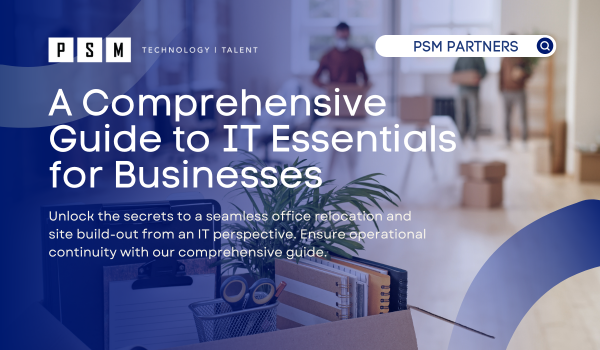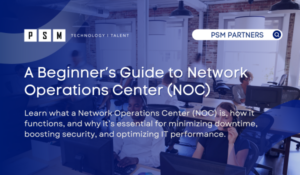Table of Contents
ToggleThe decision to relocate your company’s office or build a new site is pivotal in your business journey. This shift reflects growth, adaptation to changing business needs, and often a quest for enhanced productivity and efficiency. However, it’s essential to understand that office relocation and site build-out present a unique set of challenges from an IT perspective. Ensuring a seamless transition for your IT infrastructure is paramount to maintaining operational continuity. In this comprehensive guide, we will explore the multifaceted aspects of office relocation and site build-out, focusing on what companies need to consider from an IT perspective.
Preparing for Change
Establishing a Cross-Functional Team: Begin by forming a dedicated IT transition team. This team should include IT professionals, facilities managers, project managers, and stakeholders from various departments. Effective communication and collaboration within this team are critical to a successful transition.
Establishing a moving date well in advance is crucial for organizing various logistical aspects, including budget planning and notifying all relevant parties involved in the move.
IT Needs Assessment: Conduct a thorough IT needs assessment. Understand the existing infrastructure, hardware, software, and services used by your organization. Identify areas that require improvements, upgrades, or changes to meet your evolving business needs. Schedule a site visit to your new location with your IT team to review network cabling requirements.
Budget Allocation: Adequate budgeting is vital for your IT transition. This includes the cost of physical IT equipment and expenses related to data migration, network setup, and potential downtime. Having a clear budget will help in managing resources efficiently. Outsourcing your office move can help you stay within budget and ensure a smooth transition.
Reviewing the Current Lease and Space
Reviewing the current lease and space is a crucial step in the office relocation process. This involves assessing the current office space to determine what can be taken to the new location and what needs to be left behind. It’s essential to review the current lease to understand the terms and conditions, including the notice period, termination clauses, and any penalties for early termination.
When reviewing the current lease, consider the following factors:
Lease duration and expiration date: Know when your lease ends and if there are any options for renewal.
Rent and any rent increases: Understand your current rent and any scheduled increases.
Lease renewal or termination options: Check if there are any clauses that allow for early termination or renewal.
Subletting or assignment clauses: Determine if you can sublet the space or assign the lease to another party.
Repair and maintenance responsibilities: Clarify who is responsible for repairs and maintenance.
Insurance and liability requirements: Ensure you meet all insurance and liability requirements outlined in the lease.
Additionally, assess the current office space to determine:
What furniture and equipment can be reused or repurposed: Identify items that are still in good condition and can be used in the new office.
What needs to be replaced or upgraded: Determine which items are outdated or no longer functional.
What can be donated or sold: Consider donating or selling items that are no longer needed but still have value.
What needs to be disposed of: Properly dispose of any items that cannot be reused, sold, or donated.
By reviewing the current lease and space, you can make informed decisions about what to take to the new location and what to leave behind, ensuring a smooth transition and minimizing waste.
Planning Your IT Transition
Create a Detailed IT Transition Plan: Your IT transition plan should outline the entire process, from assessment to post-move support. It should include timelines, responsible individuals, and checkpoints for monitoring progress. Ensure that the plan aligns with your overall relocation/build-out timeline.
Network Infrastructure: Work with IT professionals to design a robust network infrastructure plan for your new location. This includes planning the layout of servers, switches, and cabling. Make sure to account for future growth and scalability in your design.
Data Backup and Migration Strategy: Establish a data backup and migration strategy that ensures the safety and accessibility of your valuable data during the transition. Back up all critical data and applications and verify that the restoration works seamlessly. Store your backup somewhere that will not be affected by the move.
Software and Licensing Inventory: Inventory all your software licenses and subscriptions. Ensure you have the necessary licenses for your new location, and update them as required. Unneeded software can be discontinued to save costs.
Evaluate your equipment: Take inventory of all your equipment – Does it still meet your needs? Does it make sense for the new location? This includes assessing the condition and performance of essential items such as printers, laptops, computer accessories, and other office equipment. Look into factors such as the age of the equipment, its compatibility with new systems or software, and any emerging technological advancements that may enhance productivity or efficiency.
Internet and Connectivity
Internet Service Provider (ISP): Coordinate with ISPs well in advance to ensure a smooth transition. Contact all carriers, ISPs (internet service providers), and technology vendors and inform them of your move date at least 2 months before the move! Verify that high-speed internet connectivity is available at the new location and that it meets your business needs.
Cloud Services: If your company relies on cloud-based services like email or document storage, verify that your cloud service provider can support the transition without disruption.
Telecommunications: Ensure that your telecommunications infrastructure, including phone lines, VoIP systems, and communication tools, is in place. Verify that phone numbers and extensions are correctly transferred to the new location.
Setting Up the New IT Environment in the New Office
Network Installation: Once you’ve reached your new location, set up and configure your network. This includes installing routers, switches, and firewalls and verifying that cabling is correctly connected. Make sure network connectivity is stable and secure.
Server Room or Data Center Design: Design a dedicated server room or data center that offers adequate space, cooling, and security for your servers and networking equipment. Maintaining the right temperature and humidity levels is essential to prevent equipment overheating.
Workstation Setup: Ensure that workstations and desktop computers are set up and configured for your employees. Install necessary software, security measures, and access controls to secure your IT environment.
Access Control and Permissions: Review and update access control and permission settings to guarantee that only authorized personnel have access to sensitive information and resources. This is a critical aspect of data security.
VoIP and Communication Systems: Set up and configure your VoIP phone system and communication tools to ensure uninterrupted internal and external communication.
Data Security and Protection
Security Assessment: Perform a comprehensive security assessment of your new IT environment. This involves verifying that firewalls, antivirus software, intrusion detection systems, and other security measures are up to date and properly configured.
Data Backup and Recovery: Implement a robust data backup and recovery system in your new location. Back up critical data regularly and test the restoration process to maintain data integrity.
Physical Security: Ensure that your new location has adequate physical security measures. These include controlled access, surveillance cameras, and secure storage for IT equipment.
Learn more about Tailgating attacks: https://www.psmpartners.com/blog/tailgating-attack/
Testing and Training
Testing: Thoroughly test all IT systems before the full transition. Check network connectivity, software functionality, and data accessibility. Identify and resolve any issues proactively to avoid post-move disruptions.
Employee Training: Provide training sessions for employees on any new IT systems or tools. Ensure they understand the changes and are comfortable with the updated IT environment.
Finalizing the Relocation Process
Update Contact Information: Notify clients, partners, and suppliers of your change in contact information. Update your website, email signatures, and other online platforms with your new address and contact details.
Decommissioning the old office is a crucial step before moving into the new space, involving logistical considerations and ensuring proper closure.
Decommission Old Equipment: Properly decommission and dispose of any outdated or no longer-needed IT equipment. Ensure sensitive data is securely wiped from retired devices.
Ongoing Support: After the transition, provide ongoing IT support to address any issues or questions that may arise. Establish a help desk or support system to assist employees with IT-related concerns.
Do you need technology deployment services for your office move?
The process of office relocation or site build-out can be both exciting and challenging. When viewed from an IT perspective, it becomes evident that meticulous planning and execution are necessary to ensure a smooth transition. A well-managed IT transition is not just about moving equipment but also about adapting to evolving business needs and embracing opportunities for growth and improvement. By following the steps outlined in this comprehensive guide, you can navigate the complexities of office relocation and site build-out, maintaining the integrity of your IT infrastructure and ensuring continued operational success.
Consider these office relocation tips to ensure a smooth transition: careful planning, hiring professionals, and maintaining clear communication with all stakeholders.
Deciding whether to utilize a deployment services company for your company office move depends on various factors, including the size of your business, the complexity of the move, and your internal resources and expertise. Here are some considerations to help you determine if it’s worth it:
Expertise and Experience: Deployment services companies specialize in managing office relocations, and they have the expertise and experience to handle various aspects of the move efficiently. If your company lacks experience in managing office moves or if the relocation is particularly complex, hiring professionals can streamline the process and mitigate risks.
Efficiency and Time-Saving: Office moves can be time-consuming and disruptive to regular business operations. Deployment services companies can manage the entire process, from planning and logistics to installation and setup, allowing your employees to focus on their core tasks without being burdened by the move. This can result in minimal downtime and a smoother transition to the new office space.
Risk Mitigation: Office moves involve inherent risks, such as damage to equipment, loss of productivity, and delays in timelines. Deployment services companies have protocols in place to mitigate these risks, such as proper packing techniques, insurance coverage, and contingency plans. By entrusting the move to professionals, you can reduce the likelihood of costly setbacks and ensure a successful relocation.
Cost Considerations: While hiring a deployment services company involves upfront costs, it’s essential to weigh these against the potential savings and benefits. Consider factors such as labor costs, potential loss of data, and potential productivity losses associated with managing the move internally. In some cases, outsourcing the move may prove more cost-effective in the long run.
Ultimately, the decision to use a deployment services company for your office move depends on your company’s unique circumstances, priorities, and budget. It may be worthwhile to consult with various service providers, obtain quotes, and weigh the pros and cons before making a decision.
Key Takeaways
Planning an office move can be a daunting task, but with the guidance provided in this manual, you can navigate the process smoothly and achieve a successful relocation. By following the steps outlined, you can minimize disruptions, boost employee morale, and establish a conducive environment for productivity and growth.
Hosting an office warming party is a great way to thank employees for their hard work and to welcome them to the new office space.
At PSM Partners, we pride ourselves on being a trusted leader in Deployment Services including office relocations. Leveraging our wealth of experience and expertise, we are dedicated to delivering tailored and hassle-free solutions for your office relocation needs. Trust PSM to make your move a seamless and stress-free experience.
Related Insights
A Beginner’s Guide to Network Operations Center (NOC)
Businesses and organizations rely heavily on complex IT infrastructures to...
Read MoreWork Remote: The Workforce Is Growing—But So Are Cybersecurity Risks
As businesses continue to evolve in response to modern demands,...
Read MoreWhat is Help Desk as a Service?
The operations of virtually every business and organization depend on...
Read MoreDocument Management vs Records Management: Which One Does Your Firm Need?
In today’s digital landscape, law firms must ensure that all...
Read MoreAbout the Author

Cody Muller
Cody Muller is a highly accomplished IT Project Manager specializing in Healthcare and Higher Education. With over seven years of experience, Cody has led projects with seamless wireless infrastructure deployment across 28 nationwide locations, serving over 50,000 onsite staff and students. His expertise includes developing sustainable IT processes for new college campuses and delivering strategic services to large healthcare organizations, ensuring exceptional end-user satisfaction.





